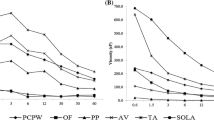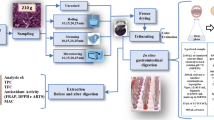Abstract
The capsicum seed core and cabbage outer leaves are common wastes generated in the vegetable processing industry. We explored the in vitro health-promoting activity of these waste products for valorization. Freeze-dried and pulverized cabbage wastes had a high bile acid binding capacity and the capsicum wastes inhibited glucose dialysis more effectively. Methanolic extracts prepared with conventional solvent extraction and ultrasound-assisted extraction were analyzed to determine their 2,2-diphenyl-1-picrylhydrazyl (DPPH) radical scavenging capacity, in vitro α-amylase inhibitory, in vitro lipase inhibitory, and prebiotic activity. Crude extracts of cabbage and capsicum wastes were screened using GC–MS analysis. The cabbage waste extracts showed high antioxidant activities but did not inhibit α-amylase. The capsicum waste extracts inhibited both lipase and α-amylase activities and supported the growth of the probiotic bacterium, Lactobacilli brevis. Volatile compounds of the vegetables consisted mainly of phenols and fatty acid esters. In all assays except the α-amylase inhibition assay, the extracts prepared with ultrasound-assisted solvent extraction showed higher activity than those prepared using the conventional method. The capsicum seed core and cabbage outer leaves are potential sources of phytochemicals and antioxidant fibers. Capsicum waste extract supported probiotic bacterial growth without a lag phase. These waste products may be processed into high-value functional ingredients.




Similar content being viewed by others
Abbreviations
- BABC:
-
Bile acid binding capacity
- DF:
-
Dietary fiber
- DPPH:
-
2,2-diphenyl-1-picrylhydrazyl
- EC50 :
-
The effective concentration of the sample extracts to scavenge half of the free radicals in the mixture (EC50)
- GDRI:
-
Glucose dialysis retardation index
- MRS:
-
de Man, Rogosa and Sharpe
- SE:
-
Solvent extraction/extracted
- UASE:
-
Ultrasound-assisted solvent extraction/extracted
References
AOAC (2000) Official methods of analysis, 17th edn. Association of Official Analytical Chemists, Arlington
Aranha BC, Hoffmann JF, Barbieri RL, Rombaldi CV, Chaves FC (2017) Untargeted metabolomic analysis of Capsicum spp. by GC–MS. Phytochem Anal 28:439–447. https://doi.org/10.1002/pca.2692
Chang YP, Sit NW, Anto Cordelia TA (2017) Guava by-products: a source of functional carbohydrates, phytochemicals and enzymes. In: Murphy A (ed) Guava: cultivation, antioxidant properties and health benefits. Nova Science Publishers Inc, New York, pp 17–50
Cornfine C, Hasenkopf K, Eisner P, Schweiggert U (2010) Influence of chemical and physical modification on the bile acid binding capacity of dietary fibre from lupins (Lupinus angustifolius L.). Food Chem 122:638–644. https://doi.org/10.1016/j.foodchem.2010.03.024
Dhingra D, Michael M, Rajput H, Patil RT (2012) Dietary fibre in foods: a review. J Food Sci Technol 49:255–266. https://doi.org/10.1007/s13197-011-0365-5
Dong XY, Shao LJ, Wang Y, Kou W, Cao Y, Zhang D (2015) Biogas by two-stage microbial anaerobic and semi-continuous digestion of Chinese cabbage waste. Chin J Chem Eng 23:847–852. https://doi.org/10.1016/j.cjche.2015.03.001
Gustavsson J, Cederberg C, Sonesson U, van Otterdijk R, Meybeck A (2011) Global food losses and food waste. Extent, causes and prevention. FAO, Rome. http://www.fao.org/fileadmin/user_upload/ags/publications/GFL_web.pdf. Accessed 14 Mar 2019
Hansawasdi C, Kurdi P (2017) Potential prebiotic oligosaccharide mixtures from acidic hydrolysis of rice bran and cassava pulp. Plant Foods Hum Nutr 72:396–403. https://doi.org/10.1007/s11130-017-0636-z
Hervert-Hernández D, Pintado C, Rotger R, Goñi I (2009) Stimulatory role of grape pomace polyphenols on Lactobacillus acidophilus growth. Int J Food Microbiol 136:119–122. https://doi.org/10.1016/j.ijfoodmicro.2009.09.016
Hong E, Kim G (2013) GC–MS Analysis of the extracts from Korean cabbage (Brassica campestris L. ssp. pekinensis) and its seed. Prev Nutr Food Sci 18:218–221. https://doi.org/10.3746/pnf.2013.18.3.218
Jerman T, Trebše P, Mozetič Vodopivec B (2010) Ultrasound-assisted solid liquid extraction (USLE) of olive fruit (Olea europaea) phenolic compounds. Food Chem 123:175–182. https://doi.org/10.1016/j.foodchem.2010.04.006
Kocsis N, Amtmann M, Mednyánszky Z, Korány K (2002) GC–MS investigation of the aroma compounds of Hungarian red paprika (Capsicum annuum) cultivars. J Food Compos Anal 15:195–203. https://doi.org/10.1006/jfca.2001.1045
Kumcuoglu S, Yilmaz T, Tarman S (2014) Ultrasound assisted extraction of lycopene from tomato processing wastes. J Food Sci Technol 51:4102–4107. https://doi.org/10.1007/s13197-013-0926-x
Li BW, Andrews KW, Pehrsson PR (2002) Individual sugars, soluble, and insoluble dietary fiber contents of 70 high consumption foods. J Food Compos Anal 15:715–723. https://doi.org/10.1006/jfca.2002.1096
Lim SY, Tham PY, Hilary Lim YL, Heng WS, Chang YP (2018) Potential functional byproducts from guava purée processing. J Food Sci 83:1522–1532. https://doi.org/10.1111/1750-3841.14155
López de Lacey AM, Pérez-Santín E, López-Caballero ME, Montero P (2014) Survival and metabolic activity of probiotic bacteria in green tea. LWT Food Sci Technol 55:314–322. https://doi.org/10.1016/j.lwt.2013.08.021
Milugo TK, Omosa LK, Ochanda JO, Owuor BO, Wamunyokoli FA, Oyugi JO, Ochieng JW (2013) Antagonistic effect of alkaloids and saponins on bioactivity in the quinine tree (Rauvolfia caffra sond.): further evidence to support biotechnology in traditional medicinal plants. BMC Complement Altern Med 13:285–290. https://doi.org/10.1186/1472-6882-13-285
Molan AL, Flanagan J, Wei W, Moughan PJ (2009) Selenium-containing green tea has higher antioxidant and prebiotic activities than regular green tea. Food Chem 114:829–835. https://doi.org/10.1016/j.foodchem.2008.10.028
Pandey KR, Naik SR, Vakil BV (2015) Probiotics, prebiotics and synbiotics: a review. J Food Sci Technol 52:7577–7587. https://doi.org/10.1007/s13197-015-1921-1
Park SY, Yoon KY (2015) Enzymatic production of soluble dietary fiber from the cellulose fraction of Chinese cabbage waste and potential use as a functional food source. Food Sci Biotechnol 24:529–535. https://doi.org/10.1007/s10068-015-0069-0
Pattnaik S, Reddy MV (2010) Nutrient status of vermicompost of urban green waste processed by three earthworm species—Eisenia fetida, Eudrilus eugeniae, and Perionyx excavatus. Appl Environ Soil Sci. https://doi.org/10.1155/2010/967526
Reshmi R (2009) Physicochemical and biochemical characterization of enzymes immobilized on inorganic matrices. PhD Thesis, Cochin University of Science and Technology, India. https://dyuthi.cusat.ac.in/jspui/bitstream/purl/3107/1/Dyuthi-T1081.pdf. Accessed 14 Mar 2019
Roh C, Jung U (2012) Nepeta japonica Maximowicz extract from natural products inhibits lipid accumulation. J Sci Food Agric 92:2195–2199. https://doi.org/10.1002/jsfa.5608
Rubio-Senent F, Rodríguez-Gutiérrez G, Lama-Muñoz A, Fernández-Bolaños J (2015) Pectin extracted from thermally treated olive oil by-products: characterization, physico-chemical properties, in vitro bile acid and glucose binding. Food Hydrocolloids 43:311–321. https://doi.org/10.1016/j.foodhyd.2014.06.001
Shah NP, Ding WK, Fallourd MJ, Leyer G (2010) Improving the stability of probiotic bacteria in model fruits juices using vitamins and antioxidants. J Food Sci 75:278–282. https://doi.org/10.1111/j.1750-3841.2010.01628.x
Sosa-Moguel O, Pino JA, Ayora-Talavera G, Sauri-Duch E, Cuevas-Glory L (2017) Biological activities of volatile extracts from two varieties of Habanero pepper (Capsicum chinense Jacq.). Int J Food Prop 20(Sup3):S3042–S3051. https://doi.org/10.1080/10942912.2017.1397694
Thompkinson DK, Bhavana V, Kanika P (2014) Dietary approaches for management of cardio-vascular health: a review. J Food Sci Technol 51:2318–2330. https://doi.org/10.1007/s13197-012-0661-8
Toorani MR, Farhoosh R, Golmakani M, Sharif A (2019) Antioxidant activity and mechanism of action of sesamol in triacylglycerols and fatty acid methyl esters of sesame, olive, and canola oils. LWT 103:271–278. https://doi.org/10.1016/j.lwt.2019.01.012
Wang Y, Zhou Y-L, Cheng Y-K, Jiang Z-Y, Jin Y, Zhang H-S, Liu D, Teng LR, Zhang G-R (2015) Enzymo-chemical preparation, physic-chemical characterization and hypolipidemic activity of granular corn bran dietary fiber. J Food Sci Technol 52:1718–1723. https://doi.org/10.1007/s13197-013-1140-6
Xiao Z, Storms R, Tsang A (2006) A quantitative starch–iodine method for measuring alpha-amylase and glucoamylase activities. Anal Biochem 351:146–148. https://doi.org/10.1016/j.ab.2006.01.036
Yoo H-D, Kim D, Paek S-H, Oh S-E (2012) Plant cell wall polysaccharides as potential resources for the development of novel prebiotics. Biomol Ther 20:371–379. https://doi.org/10.4062/biomolther.2012.20.4.371
Zhao G, Zhang W, Zhang G (2010) Production of single cell protein using waste capsicum powder produced during capsanthin extraction. Lett Appl Microbiol 50:187–191. https://doi.org/10.1111/j.1472-765X.2009.02773.x
Acknowledgements
This study was supported by Universiti Tunku Abdul Rahman, Malaysia through the internal grant IPSR/RMC/UTARRPS/2017/75. We thank Veg Station (M) Sdn. Bhd. for supplying the cabbage outer leaves and capsicum seed core.
Author information
Authors and Affiliations
Corresponding author
Additional information
Publisher's Note
Springer Nature remains neutral with regard to jurisdictional claims in published maps and institutional affiliations.
Electronic supplementary material
Below is the link to the electronic supplementary material.
Rights and permissions
About this article
Cite this article
Liang, J.L., Yeow, C.C., Teo, K.C. et al. Valorizing cabbage (Brassica oleracea L. var. capitata) and capsicum (Capsicum annuum L.) wastes: in vitro health-promoting activities. J Food Sci Technol 56, 4696–4704 (2019). https://doi.org/10.1007/s13197-019-03912-5
Revised:
Accepted:
Published:
Issue Date:
DOI: https://doi.org/10.1007/s13197-019-03912-5




